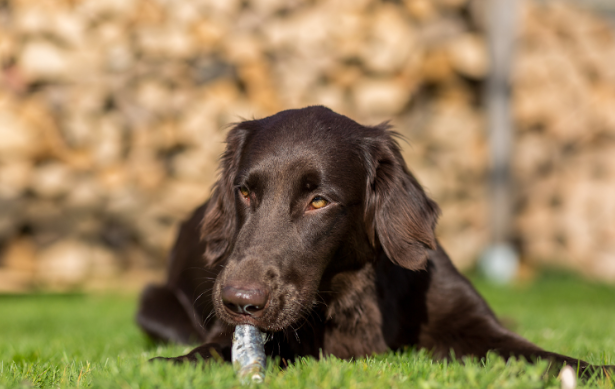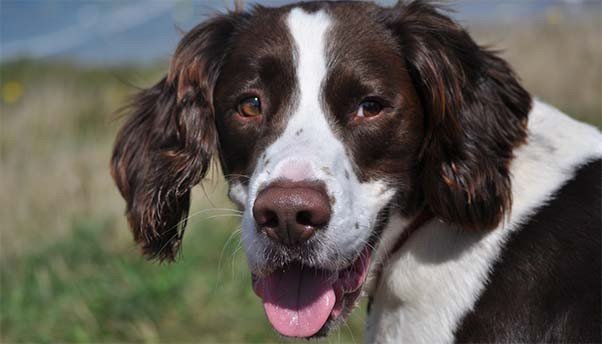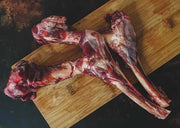Canine Weight Loss Secrets

One of the top questions we are asked here at The Farmer’s Dog is on weight balance, and how much a dog should be fed daily.
When feeding fresh raw food it is safe to adjust the amount fed daily, within reason. Our feeding guide can help you reach a base point but your dog will always have an individual metabolism that food can be adjusted to match.
If your dog needs to lose weight it is always much better to consider the type of foods being fed rather than the volume of food they eat.
How dogs differ from us in metabolism and weight balanceTraditionally obesity and weight gain are considered the result of either excess food consumption or lack of exercise. Occasionally genetic- or ailment-related reasons are mentioned too.
Whilst this way of looking at things is important in dogs, and cats too, it is not the whole story.
It is important to understand that dogs have eight ways to raise their blood sugar, yet only one way to reduce it1, and this is insulin.
Insulin encourages dogs’ bodies to lay fat.
This means that each time they eat a meal containing a grain or carbohydrate they will release lots of insulin in an effort to reduce their blood sugar levels, and lay more fat in their fat cells. This happens especially if the carbohydrate is a refined version such as rice, wheat or corn.
Feeding excess fat only becomes an issue if the type of fat is a heated, processed version. Fats known as trans-fatty acids also lead to weight gain.
These are also the inflammatory type of fats so to avoid these, simply make sure the foods fed are fresh, unprocessed and not heated to high temperatures.
Essentially, for weight loss feed your dog more protein and less or even no starchy carbohydrates at all.
It is a myth that dogs need carbs, starches or fibre for energy. Pet dogs are not getting anywhere near the exercise levels to need the quick release that carbohydrates provide.
Veterinary packaged foods oddly offer entirely the opposite ingredients to the dog’s biological needs as they are packed with refined carbohydrates, despite the fact the physiology and the research actually shows higher protein to be of more benefit to a dog’s weight loss.2
Often the foods suggested at traditional vet practices are able to carry a statement of marketing surrounding weight, such as being a Light or Diet recipe, following Aafco (Association of American Feed Control Officials) studies that require only eight dogs and involve just two or three processed foods, with the final recipe sold offering the least weight gain, or most weight loss, of those in the study. Usually, and sadly, the loss is due to muscle degradation. Muscle, as we know, weighs more than fat.
Dogs are biologically designed to take their energy from fats, and specifically, a set of omega fats that are also related to the anti-inflammatory pathways in the dog’s body.
For that reason when dogs are obese, or even as they begin to gain weight, they are also more likely to suffer from inflammatory ailments such as gastroenteritis, arthritis or pancreatitis too3. All those ailments are supported by a switch to eating fresh wholefoods.
Canine Weight Loss Round-up
Top reasons to choose fresh foods over processed
🐾 Processed Light or Diet foods for dogs are higher in starches, lower in protein.
They contain fatty acids that influence weight gain and reduce mobility (much needed for that extra exercise!).
🐾 Processed dog foods are also well-known to influence the microbiome balance4 to a less healthy state, and thus encourage the laying down of fat in the dog’s body.
🐾 Deficiencies in nutrients such as vitamin D, iron and even calcium5 have been linked to weight gain. These nutrients have to be added to processed pet foods after the cooking procedures but are rarely added back in absorbable, bio-available forms and in the case of calcium, never. Only fresh food fully provides these nutrients to your dog.
Can supplements help?
Whilst we believe diet holds the key to weight changes, fatty tissue is known to hide away various toxins that accumulate, for all sorts of reasons, from simply breathing in air pollution to previous diet ingredients or additives.
It helps to support your dog with a liver blend from a trusted veterinary herbalist if your dog is on a weight loss plan. Until the toxins are removed, the fat cells remain stubborn.
It is known that kelp also supports metabolism, this is a useful addition to a canine weight loss plan. Always follow dosages suggestion on the canine kelp you purchase.
(Find a Vet www.herbalvets.org.uk)
Ultimately, we all know deep down that a fresh food diet is healthier for the body and the concept that it is an unhealthy body that lays down or stores fat is gaining traction.
1 Ruined by Excess, Perfected by Lack – The Paradox of Pet Nutrition by veterinary nutritionist Dr Richard Patton.
2 High protein works better for canine weight loss than fibre-rich Light foods.
https://pubmed.ncbi.nlm.nih.gov/9524636/
https://academic.oup.com/jn/article/134/8/2148S/4688901
https://academic.oup.com/jn/article/132/6/1685S/4687693
3 Obesity, its associated disorders and the role of inflammatory adipokines in companion animals https://onlinelibrary.wiley.com/doi/full/10.1111/jvim.15367
https://www.biorxiv.org/content/10.1101/2020.01.06.896399v1.ful
4 https://link.springer.com/article/10.1186 /s13099-017-0218-5 - 2017
https://bmcvetres.biomedcentral.com/articles/10.1186 /s12917-017-0981-z
https://doi.org/10.1080/00480169.2021.1975586 (microbiome effects on protein and fat utilisation)
5 https://www.ncbi.nlm.nih.gov/pmc/articles/PMC4010554/













